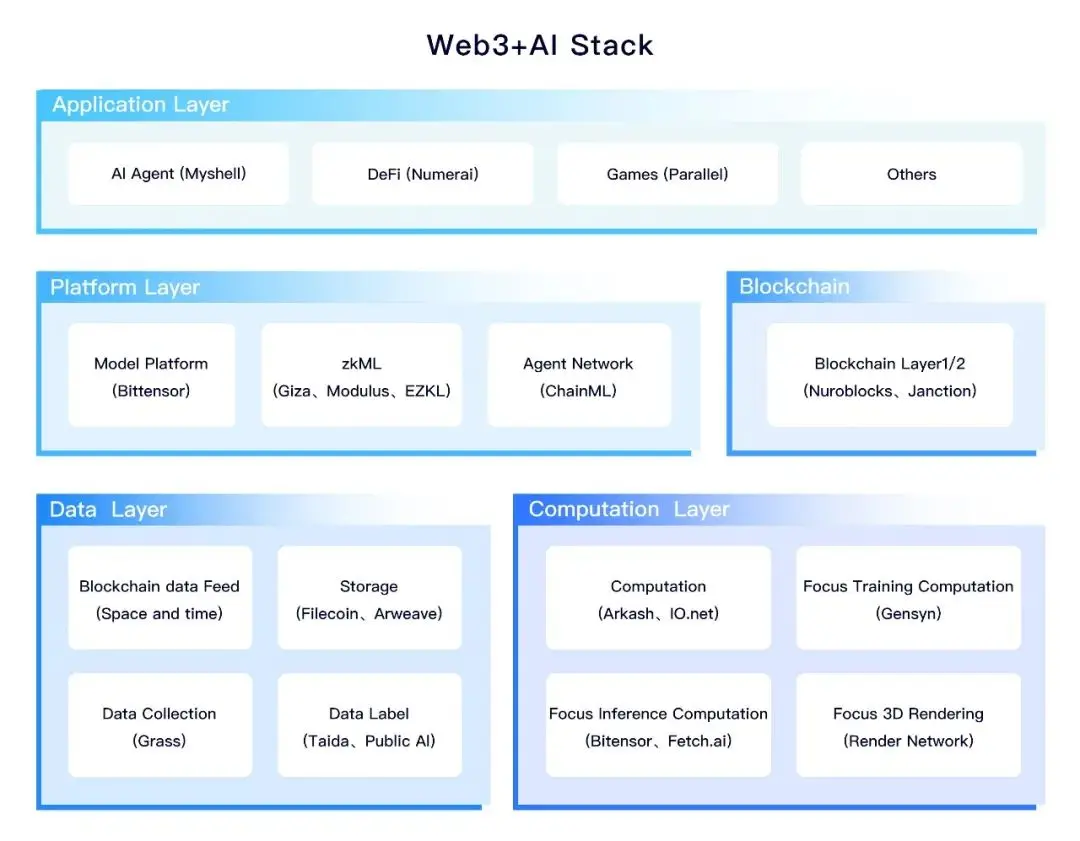Web3 + AI: Building Sovereign AI to Meet the Interests and Demands of the Crypto Community
Author: IOBC Capital
During his speech at WGS in Dubai, Jensen Huang introduced the term "sovereign AI." So, which sovereign AI can align with the interests and demands of the Crypto community?
Perhaps it needs to be built in the form of Web3 + AI. Vitalik discussed the synergy between AI and Crypto in his article "The promise and challenges of crypto + AI applications": the decentralization of Crypto can balance the centralization of AI; AI is opaque, while Crypto brings transparency; AI needs data, and blockchain is conducive to data storage and tracking. This synergy runs throughout the entire industrial landscape of Web3 + AI.
Most Web3 + AI projects are utilizing blockchain technology to address the construction issues of AI industry infrastructure, while a few projects use AI to solve certain problems in Web3 applications. The industrial landscape of Web3 + AI is roughly as follows:
 The production and workflow of AI are roughly as follows:
The production and workflow of AI are roughly as follows:
 In these links, the combination of Web3 and AI is mainly reflected in four aspects:
In these links, the combination of Web3 and AI is mainly reflected in four aspects:
1. Computing Power Layer: Assetization of Computing Power
In the past two years, the computing power used to train large AI models has grown exponentially, essentially doubling every quarter, far exceeding Moore's Law. This situation has led to a long-term imbalance between supply and demand for AI computing power, causing rapid increases in the prices of hardware like GPUs, thereby raising the cost of computing power.
However, at the same time, there is also a large amount of idle mid-to-low-end computing hardware in the market. While the individual computing power of this mid-to-low-end hardware may not meet high-performance demands, if a distributed computing power network is built through Web3, utilizing computing power leasing and sharing, it can still meet many AI application needs. By utilizing distributed idle computing power, the cost of AI computing power can be significantly reduced.
The computing power layer can be subdivided into:
- General decentralized computing power (e.g., Arkash, Io.net, etc.);
- Decentralized computing power for AI training (e.g., Gensyn, Flock.io, etc.);
- Decentralized computing power for AI inference (e.g., Fetch.ai, Hyperbolic, etc.);
- Decentralized computing power for 3D rendering (e.g., The Render Network, etc.).
The assetization of computing power in Web3 + AI has a core advantage in that decentralized computing power projects, combined with token incentives, can easily scale the network, and their computing resource costs are low, providing high cost-effectiveness to meet some mid-to-low-end computing power demands.
2. Data Layer: Assetization of Data
Data is the oil and blood of AI. Without relying on Web3, only large enterprises typically possess vast amounts of user data, making it difficult for ordinary startups to obtain extensive data, and the value of user data in the AI industry is not returned to users. Through Web3 + AI, the processes of data collection, data labeling, and distributed data storage can be made more cost-effective, transparent, and beneficial to users.
Collecting high-quality data is a prerequisite for training AI models. By utilizing a distributed network through Web3, combined with appropriate token incentive mechanisms, crowdsourcing methods can be employed to obtain high-quality and extensive data at a lower cost.
Depending on the project’s purpose, data-related projects mainly include the following categories:
- Data collection projects (e.g., Grass, etc.);
- Data trading projects (e.g., Ocean Protocol, etc.);
- Data labeling projects (e.g., Taida, Alaya, etc.);
- Blockchain data source projects (e.g., Spice AI, Space and Time, etc.);
- Decentralized storage projects (e.g., Filecoin, Arweave, etc.).
Data-related Web3 + AI projects face more challenges in designing token economic models because data is harder to standardize than computing power.
3. Platform Layer: Assetization of Platform Value
Most platform projects will benchmark against Hugging Face, focusing on integrating various resources in the AI industry. Establishing a platform that aggregates data, computing power, models, AI developers, blockchain, and other resources and roles at its center can more conveniently address various needs. For example, Giza focuses on building a comprehensive zkML operating platform aimed at making machine learning inference trustworthy and transparent, as the black box of data and models is a common issue in AI. Using Web3 methods with cryptographic technologies like ZK and FHE to verify that model inference is executed correctly will eventually be called for within the industry.
There are also layer 1/layer 2 projects focused on AI, such as Nuroblocks and Janction. The core narrative is connecting various resources like computing power, data, models, AI developers, and nodes, helping Web3 + AI applications achieve rapid construction and development by packaging general components and SDKs.
Additionally, there are Agent Network-type platforms that can build AI Agents for various application scenarios, such as Olas and ChainML.
Platform-type Web3 + AI projects primarily capture platform value through tokens, incentivizing all participants to co-build the platform. This can be particularly helpful for startups in the process of going from 0 to 1, reducing the difficulty of finding partners for computing power, data, AI developer communities, nodes, and more.
4. Application Layer: Assetization of AI Value
The previous infrastructure projects mainly utilize blockchain technology to address the construction issues of AI industry infrastructure. Application layer projects, on the other hand, focus more on using AI to solve problems existing in Web3 applications.
For instance, Vitalik mentioned two directions in his article that I find very meaningful.
First, AI as a participant in Web3. For example, in Web3 Games, AI can act as a game player, quickly understanding game rules and efficiently completing game tasks; in DEX, AI has played a role in arbitrage trading for many years; in prediction markets, AI Agents can train their model's analytical prediction capabilities by widely accepting large amounts of data, knowledge bases, and information, and productize this to help users make predictions about specific events, such as sports events and presidential elections.
Second, creating scalable decentralized private AI. Many users are concerned about the black box issue of AI and the potential biases in the system; or they worry that certain dApps may deceive users for profit using AI technology. Essentially, this is because users lack oversight and governance rights over the model training and inference processes of AI. However, if a Web3 AI is created, where the community has distributed governance rights over the AI like Web3 projects, it may be more readily accepted.
As of now, there have not yet been any high-ceiling white horse projects in the Web3 + AI application layer.
Conclusion
Web3 + AI is still in its early stages, and there are differing opinions within the industry regarding the development prospects of this track. We will continue to pay attention to this track. We hope that the combination of Web3 and AI can create products that are more valuable than centralized AI, allowing AI to break free from labels like "giant control" and "monopoly," and to "co-govern AI" in a more community-oriented manner. Perhaps through closer participation and governance, humanity will have more "awe" and less "fear" towards AI.










